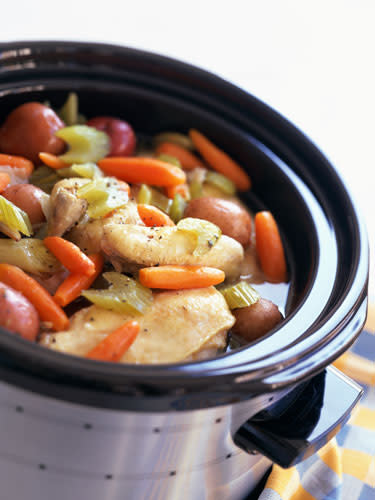Slow Cooking 101

By Mandy Major
Slow cooking is the savoir of a hectic home kitchen: It's almost entirely hands-free, requires zero technique and can be amazingly economical. And contrary to what you may think, it's fit for more than just wintertime fare. Use it year-round to create meaty main dishes, soups, stews, grain side dishes and even cakes. That said, some ingredients hold up better to slow cooking than others, and while slow cooking is simple, a few pointers can make for more memorable meals. To help us navigate the basics, we turned to Linda Eckhardt, a James-Beard-Award-winning cookbook author and editor of EverybodyEatsNews.com, for a rundown of everything low-and-slow. Read on for essential do's, don'ts andcooking tipsthat'll help you make the most of the ingredients you have on hand.
Photo by Rita Maas/Getty
Slow Cooking Meat
In this case, it pays to be thrifty! Skip pricier prime and choice cuts and go for tougher, thicker cuts. They respond well to slow cooking, which breaks down the fibrous tissue until it's soft and tender. Try lamb or pork shoulder (aka pork butt), beef pot roast or brisket, turkey hind quarters or chicken thighs.
Although lean cuts can work (with less cooking time than their marbled counterparts, however), Eckhardt suggests putting meat in whole. "When it has bones or skin you'll get better flavor," she says. Once cooked, discard the skin and bones and shred the meat for serving.
Recipes to try:
Slow Cooker Spring Beef & Vegetable Stew
Slow Cooker Balsamic-Ginger Chicken Lettuce Cups
Slow Cooking Grains, Fruits and Veggies
As with meat, opt for ingredients with heft, which stand up better to long cook times.
Grains: Whole grains, such as kasha, brown rice, bulgur and whole oats, work best. "Avoid any refined grain like white rice; if it's cooked all day it's going to be wallpaper paste," says Eckhardt. Pasta can work, but add it at the end, around the last 20 minutes of cooking.
Fruit: Steer clear of citrus and stone fruits (like cherries, peaches and apricots), which are too fragile for this cooking method. Instead, use dense fruit, such as apples and pears, cut into slices.
Vegetables: In general, root vegetables (such as carrots, sweet potatoes and turnips) are best-they're dense and fibrous and need time to break down. Avoid delicate veggies such as peas or green beans, unless you toss them in at the very end of cooking. Cut your vegetables in big chunks; as Eckhardt says, "there's no point in creating nice, diced shapes because they'll just dissolve."
Recipes to try:
Slow Cooker Sausage, Potato and Onion-Stuffed Peppers
Slow Cooker Applesauce Spice Cake
Do's and Don'ts
1. Always read the instructions included with your slow cooker.
2. Unplug your slow cooker when it's not in use.
3. Don't submerge a one-piece slow cooker, or the base of a multi-piece slow cooker, to clean it-it could compromise the heating component's functionality or even give you a shock. Instead, follow the cleaning instructions in the owner's manual (though you're usually safe wiping up drips with a wet cloth or paper towel).
4. Don't place a one-piece slow cooker, or the base containing the heating element, in the dishwasher. It can damage the machine.
5. Heed your slow cooker's fill line. If it's packed too full, it can boil over and make a mess.
Rules of Thumb
Cook time: This will vary based on your machine and the recipe, but in general, expect 6 to 8 hours on a low setting, and 3 to 4 hours on high. If you're concerned about timing, use the low setting. That way, you'll likely have two extra hours to go about your business while your meal cooks, says Eckhardt. "Dinner isn't going to be ruined if you have to do chores after work," she adds.
Measurements: Going without a recipe? Eckhardt gives this general guideline: 1/4 meat + 1/4 grain + 1/2 vegetable and enough liquid to cover the ingredients (see below for details). You can use water, or try chicken stock, beef broth or beer for more intense flavor.
Liquid: There's very little evaporation with slow cooking, so plan accordingly. Unless you're making soup, limit the liquid. As a rough guide, Eckhardt recommends placing your pointer finger, nail down, on the highest point of your ingredients and filling the vessel with liquid up to the bottom of the closest knuckle.
Original article appeared on WomansDay.com.
You Might Also Like:
15 Fiber-Packed Foods
Healthy Afternoon Snacks That Keep You Full
8 Secrets of Sexually Satisfied Couples
10 Surprising Facts About Orgasms
Become a fan of Woman's Day on Facebook and Twitter.

